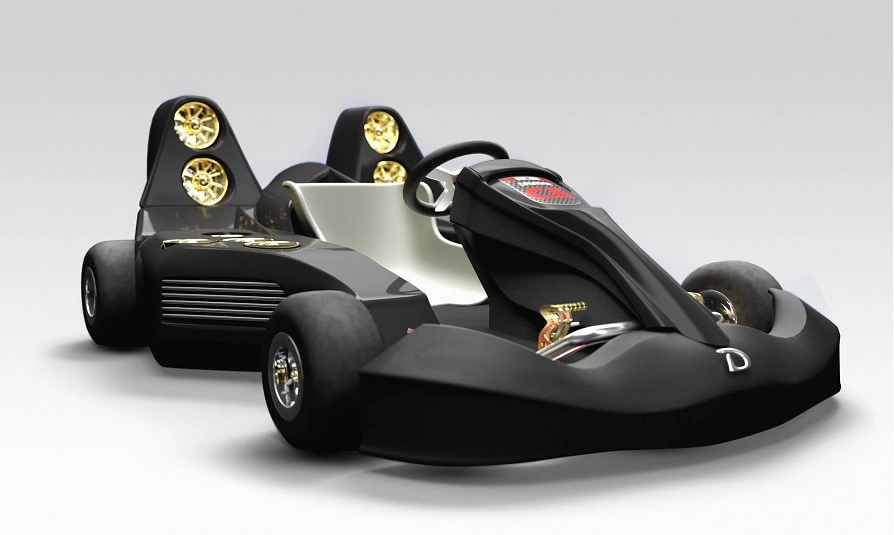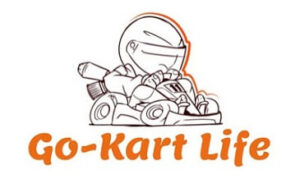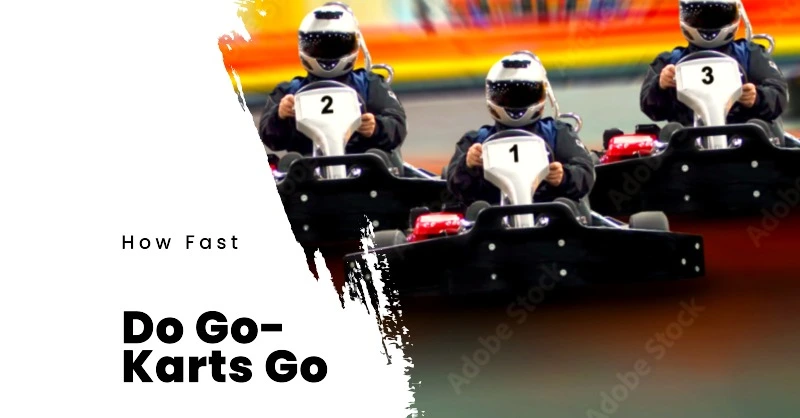If you’ve ever been to a go-kart track, you’ve probably wondered, how fast do go-karts go?” Speed is a major factor contributing to the adrenaline rush and excitement that comes with go-karting. In this article, we’ll explore the factors determining go-kart speeds, the different types of go-karts, and their top speeds, and answer some common questions about them. Strap in and get ready for an exciting ride!
| Key Takeaways |
|---|
| High-speed indoor speedway: Indoor go-kart tracks provide a thrilling racing experience, often featuring electric go-karts with impressive acceleration and top speeds ranging from 20 to 50 miles per hour, catering to a variety of skill levels and preferences. |
| Electric vs. gas go-karts: Electric go-karts offer better acceleration and torque, making them popular choices for high-speed indoor speedways, while gas-powered go-karts, often equipped with 2-stroke and 4-stroke engines, provide higher top speeds for outdoor tracks and events. |
| Fast-paced racing: Some of the fastest go-karts, like the 250cc superkart, can achieve speeds over 140 mph, while more recreational karts may reach around 50-80 mph, providing a thrilling motorsport experience for drivers of all skill levels. |
| Maintaining speed and control: Efficiently navigating track conditions and effectively applying power and braking are crucial for go-kart racing, allowing drivers to maintain high speeds and ensure safety on the track. |
| Acceleration and power: Top-performing go-karts, such as the world's fastest Daymak C5 Blast, can reach 60 mph in just 1.5 seconds due to advanced engine technologies and lightweight materials, making for an adrenaline-pumping racing experience. |
Factors Affecting Go-Karts Speeds
Several factors can impact a go-kart’s speed, including:
- Engine size and type: The engine’s power directly affects how fast a go-kart can go. Larger and more powerful engines generally result in faster go-karts. Gas-powered engines typically deliver more speed than electric ones, but electric engines offer impressive acceleration and torque. For a deep dive into the differences between electric and gas go-karts, check out our article on electric vs. gas go-karts.
- Chassis weight: A lighter chassis allows for better acceleration and higher top speeds. Karting enthusiasts often invest in lightweight materials to reduce the overall weight of their go-kart.
- Driver weight: Heavier drivers may experience slightly lower top speeds due to the added weight the engine must propel.
- Track design and conditions: Track design and conditions, such as sharp turns, elevation changes, and wet surfaces, can impact a go-kart’s speed. Learning to navigate these challenges effectively can help you maintain higher speeds on the track.
Related Article: 10 Best Go-Kart Engines
Go-Kart Classes and Their Maximum Speeds
There are several go-kart classes, each with different specifications and top speeds:
| Go-Kart Class | Age Group | Engine Type | Maximum Speed |
|---|---|---|---|
| Kid/Baby Kart Class | 5-8 years | 50cc 2-stroke | ~20 mph |
| Cadet Class | 8-12 years | 60-100cc | 30-50 mph |
| Junior Class | 13-15 years | 100-125cc | 60-70 mph |
| Lo206 Class | 16+ years | Predator 212 | 50-60 mph |
| 125cc Tag Class | 16+ years | 125cc 2-stroke | 70-80 mph |
| Shifter 125cc Class | 16+ years | 125cc 6-speed | 80-100 mph |
| Masters Class | 30+ years | 125cc-175cc | Up to 100 mph |
| 250cc Superkart Class | 16+ years | 250cc 2-stroke | Over 140 mph |
*Note that the age group is a general guideline and may vary depending on the specific karting organization or event.
Below is a brief description of each go-kart class, including the age group they cater to and their top speeds:
- Kid/Baby Kart Class: Designed for young children between 5 to 8 years old, these karts typically have a top speed of around 20 mph.
- Cadet Class: Suitable for slightly older and more experienced children aged 8 to 12, Cadet karts can reach 30-50 mph speeds.
- Junior Class: Catering to teenagers aged 13 to 15, these karts can achieve up to 60-70 mph speeds, providing a thrilling experience for young racers.
- Lo206 Class: Aimed at racers aged 16 and older, these go-karts use a Predator 212 engine, which can reach speeds of approximately 50-60 mph, depending on the specific setup.
- 125cc Tag Class: With more powerful 125cc 2-stroke engines, these go-karts can reach 70-80 mph speeds, making them popular among experienced adult racers aged 16 and older.
- Shifter 125cc Class: Featuring a 6-speed gearbox, shifter karts can achieve top speeds of 80-100 mph, offering an adrenaline-pumping ride for racers aged 16 and older.
- Masters Class: Designed for experienced adult racers aged 30 and older, these karts can reach 100 mph speeds.
- 250cc Superkart Class: Boasting the fastest speeds of any kart class, these powerful machines can reach speeds over 140 mph for racers aged 16 and older.
For more information and guidance on finding the right class, check out our comprehensive go-kart racing classes guide.
Indoor Go-Kart Speeds
Indoor go-kart tracks are designed to provide a fun and exciting racing experience in a more controlled and confined environment. Due to space constraints, tighter turns, and the proximity of other racers, indoor go-karts generally have lower top speeds than their outdoor counterparts.
- Standard Indoor Go-Karts: Most indoor go-kart tracks utilize karts with top speeds ranging from 20-45 mph. These karts cater to a wide audience, from casual racers and beginners to those seeking a moderate thrill.
- High-Performance Indoor Go-Karts: Some indoor tracks offer high-performance go-karts, achieving up to 50 mph speeds. These karts are often electric, providing instant torque and quicker acceleration. They are typically reserved for experienced racers or those seeking a more intense racing experience.
Factors Affecting Indoor Go-Kart Speeds
Several factors contribute to the achievable speeds of indoor go-karts:
- Track Design: Indoor tracks are often characterized by tight corners and shorter straightaways, limiting the attainable top speeds. Racers must navigate these challenging courses while maintaining control and adhering to safety regulations.
- Track Conditions: The surface of indoor go-kart tracks can vary in grip and cleanliness. Slippery or dusty tracks may require drivers to slow down and exercise caution, impacting the speeds achieved.
- Go-Kart Performance: The type and condition of the go-kart itself, such as engine size, weight, and tire grip, also play a significant role in determining the achievable speeds.
- Driver Skill: A skilled driver can navigate the indoor track efficiently, taking advantage of straightaways to gain speed and braking effectively in tight turns.
Outdoor Go-Kart Speeds
Outdoor go-kart tracks offer a unique racing experience with fewer space constraints and a more diverse range of kart classes, resulting in higher top speeds than indoor tracks. Here’s an overview of outdoor go-kart speeds:
- Recreational Outdoor Go-Karts: These karts are designed for casual racers and those new to the sport. They typically have top speeds ranging from 25-45 mph, providing a fun and accessible experience.
- Competitive Outdoor Go-Karts: For more experienced racers, outdoor go-kart tracks offer various classes with higher performance and top speeds. Speeds in these classes can range from 50 mph in the Lo206 class to over 140 mph in the 250cc Superkart class.
Factors Affecting Outdoor Go-Kart Speeds
Several factors influence the achievable speeds of outdoor go-karts:
- Track Design: Outdoor tracks often have longer straightaways and wider turns, allowing racers to achieve higher top speeds. The track layout, elevation changes, and corner types impact the speeds drivers can reach.
- Track Conditions: Outdoor track conditions vary depending on weather, temperature, and track maintenance. Wet or slick surfaces can result in slower speeds, as drivers must exercise caution and control.
- Go-Kart Performance: The specific kart class and its engine size, weight, and tire grip significantly impact the achievable speeds on an outdoor track. Higher-performance karts can reach much faster speeds than recreational karts.
- Driver Skill: As with indoor karting, the driver’s skill plays a crucial role in achieving higher speeds. Skilled drivers can navigate the outdoor track efficiently, optimizing acceleration, braking, and cornering to maximize speed.
For more information about indoor karting and a comparison with outdoor karting, check out our article on indoor vs. outdoor go-karting.
Related Article: Go-Kart Speedometer Installation: Step-by-Step Guide
The Fastest Kart: Daymak C5 Blast
The Daymak C5 Blast is a state-of-the-art go-kart that has garnered attention for its incredible performance capabilities. Designed and manufactured by Daymak, a Canadian company known for its innovative electric vehicles, the C5 Blast redefines what is possible in the world of go-kart racing.

Built with a unique combination of an electric motor and 12 Electric Ducted Fan (EDF) motors, the C5 Blast delivers astonishing power and speed. The kart’s chassis is constructed using high-quality carbon fiber, which reduces weight and enhances overall performance.
Some of the key specifications of the Daymak C5 Blast include the following:
- Motor: Electric with 12 EDF motors
- Frame: Carbon fiber
- Battery: Lithium-Ion (48V / 10 kWh)
- Weight: Approximately 200 kg (440 lbs)
Acceleration and Top Speed
The Daymak C5 Blast boasts remarkable acceleration and top-speed capabilities surpassing traditional racing go-karts. With its advanced powertrain, which features a 4-stroke engine, the C5 Blast can accelerate from 0 to 60 mph in an astonishing 1.5 seconds, making it one of the fastest-accelerating vehicles in the world and arguably the world’s fastest go-kart.
Regarding the top speed of a go-kart, the C5 Blast can achieve high speeds well beyond 100 mph, significantly faster than most conventional superkarts. However, it is essential to note that the actual top speed may vary depending on factors such as track conditions, driver skill, and the specific setup of the racing go-kart.
Different engine sizes are available in motorsport, with the C5 Blast’s 200cc engine contributing to its impressive performance. This kart is pretty fast and designed to look fast and maintain speed during competitive events.
Overall, the Daymak C5 Blast represents the pinnacle of go-kart performance in motorsport. It offers a thrilling, adrenaline-pumping experience for those who dare to take it for a spin. Remember that this exceptional machine is designed for advanced racers and should be handled cautiously, especially by those new to the sport.
Related Article: The Daymak C5 Blast: Fastest Go-Kart In The World
Conclusion
Go-kart speeds vary significantly depending on the type of kart, engine size, weight, and track conditions. Whether you’re a casual go-karter or a competitive racer, understanding the factors affecting your kart’s speed will help optimize your karting experience. For more resources on go-karting, check out GoKartLife for informative articles and guides to help you get the most out of your time on the track.

Goran, an experienced go-kart racer, fuels GoKartLife.com with his passion and expertise. He offers valuable insights and tips for fellow enthusiasts, fostering the growth of the go-kart community. Join Goran at GoKartLife.com and immerse yourself in this exhilarating sport.

